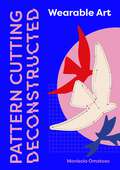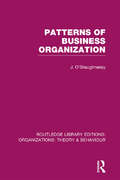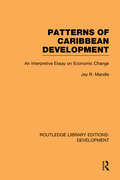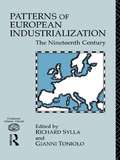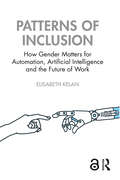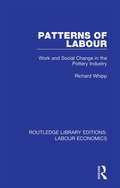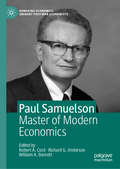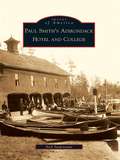- Table View
- List View
Pattern Cutting Deconstructed: Wearable Art
by Monisola OmotosoShape, form, colour and line are the visual language of abstract art and the inspiration for the designs in this creative pattern cutting book. Taking paintings by influential international artists from the early 20th century to the current day - from Matisse to Turner Prize winner Lubaina Himid - as her starting point, fashion designer and educator Monisola Omotoso offers an exciting alternative approach to developing patterns and draping on the dress form. Just as abstract art transforms reality, abstract art can be transformed into real, wearable fashion pieces.Each project begins with a work of art and a short text about the artist. The author then guides the reader through an illustrated step-by-step description of the pattern drafting and draping process of creating a garment inspired by the art.
Pattern Cutting Deconstructed: Wearable Art
by Monisola OmotosoShape, form, colour and line are the visual language of abstract art and the inspiration for the designs in this creative pattern cutting book. Taking paintings by influential international artists from the early 20th century to the current day - from Matisse to Turner Prize winner Lubaina Himid - as her starting point, fashion designer and educator Monisola Omotoso offers an exciting alternative approach to developing patterns and draping on the dress form. Just as abstract art transforms reality, abstract art can be transformed into real, wearable fashion pieces.Each project begins with a work of art and a short text about the artist. The author then guides the reader through an illustrated step-by-step description of the pattern drafting and draping process of creating a garment inspired by the art.
Pattern Recognition: How Our Mental Processes Increase the Likelihood of Making Flawed Decisions
by Sydney Finkelstein Jo Whitehead Andrew CampbellPattern recognition is a great friend to decision makers. It allows us to make (mostly) good judgments, filling in gaps in information based on our past experience. This process is not foolproof, however, and can cause failures in judgment if we're not careful, especially when we think we have sufficient relevant experience in situations when we do not. As the authors explain in this chapter, we need to identify when erroneous pattern recognition may occur and put in place some defenses to reduce the risk of making flawed decisions. They use the example of Quaker's failed acquisition of Snapple to illustrate the point. This chapter was originally published as chapter 2 of "Think Again: Why Good Leaders Make Bad Decisions and How to Keep It From Happening to You."
Pattern, Price and Time
by James A. HyerczykPraise for Pattern, Price & Time Second Edition"Jim's breadth of knowledge spans futures, Forex, stocks, Gann, charting, price patterns, and the list goes on and on. He is a valued contributor to the TraderPlanet.com community and this book further demonstrates his unwavering commitment to educating traders to help them become more successful." -Lane J. Mendelsohn, Publisher, TraderPlanet.com"James Hyerczyk provides an illuminating guide to the fascinating world of Gann Theory and the combined analysis of price, pattern, and time. This book is very interesting from both a historical and practical technical perspective."-Dan Blystone, Editor, TradersLog.com"I have known James Hyerczyk since 1991. I have always valued W. D. Gann's methods. Reading Jim's book, Pattern, Price & Time, Second Edition is a good way to get started in learning the concepts of Gann's methodology. I highly recommend this book." --Michael Popilchak, Director of Sales & Marketing, The Sweet Futures Division of Rosenthal Collins Group LLC "Hunting out good opportunities involves good tracking. Jim has taken his vast experience with Gann's proven technical analysis, to show the savvy investor the foot prints in the snow to find those successful trades. As the Chief Investment Officer of LaSalle St. Securities, I have found over the last thirty-five years that good technical analysis is invaluable."-Jay C. Carstensen, Chief Investment Officer, LaSalle St. Securities, LLC
Patternless Sewing Mod Style
by Patty Prann YoungMake a fantastic wardrobe custom-fitted to anyone’s measurements Sew a complete wardrobe without pricey paper patterns! Learn the secrets to pattern-free garment making as you measure, cut, and sew for a fabulous fit every time. Create 24 easy-to-wear garments for women and girls, personalized with a variety of pockets, belts, and hem bands. From a maxi skirt to a shirred blouse and even a raincoat, these projects are ideal for beginning sewists and women of all sizes. Express your passion for fashion—this gorgeous collection of all-seasons styles costs less than the price of a few tissue-paper patterns! • Create classic looks with a custom fit! Sew 24 patternless garments for women and girls • Get a flattering fit on all body types, from children to plus size, without the hassle of paper patterns • Countless ways to personalize each look with 8 add-ons like pockets, belts, and hem bands
Patterns In Safety Thinking: A Literature Guide to Air Transportation Safety
by Geoffrey R. McIntyreSafety is more than the absence of accidents. Safety has the goal of transforming the levels of risk that are inherent in all human activity, while its interdisciplinary nature extends its influence far into most corporate management and government regulatory actions. Yet few engineers have attended a safety course, conference or even a lecture in the area, suggesting that those responsible for the safe construction and operation of complex high-risk socio-technical systems are inadequately prepared. This book is designed to meet the expressed needs of aviation safety management trainees for a practical and concise education supplement to the safety literature. Written in a highly readable and accessible style, its features include: ¢ detailed analysis of the forward-looking System Safety approach, with its focus on accident prevention; ¢ classification of transportation safety literature into distinct schools of thought (Tort Law, Reliability Engineering, System Safety Engineering); ¢ real world, practical, illustrations of the theory; ¢ the history, theory and practice of safety management ; ¢ inter-disciplinary thinking about safety . The flying public is faced with a bewildering array of aviation safety data from a diverse and ever increasing number of sources. This book is an essential guide to the available information, and a major contribution to the international public debate on aviation safety.
Patterns of Business Organization: Organizations: Patterns Of Business Organization (Routledge Library Editions: Organizations)
by John O'ShaughnessyThis book is a successor to the earlier and widely-used Business Organization. In this book the author helps the student to develop his or her own critical and conceptual understanding of the subject. As the author reviews the various approaches – classical, human relations, behavioural science, systems and contingency theories – he shows that none of them offers a simple progression from error to truth, but that all of them combine to contribute to a broader view of the field. The final chapter summarizes the author’s viewpoint, applying the different approaches to a particular case study.
Patterns of Caribbean Development: An Interpretive Essay on Economic Change (Routledge Library Editions: Development #Vol. 2)
by Jay MandleFirst published in 1982, this study attempts to put contemporary Caribbean development into historical perspective. By first constructing a Marxist framework for the study of development , Jay Mandle assesses the reasons why the region emerged underdeveloped and evaluates post-world-war two efforts to overcome the legacy of poverty through a strategy of "industrialization through invitation." Identifying the reasons why a Marxist framework yielded results which were unsatisfactory, the author then explores the requirements which must be met for a more reliable study of the Caribbean’s economic development. Case studies of Cuba, Jamaica, Guyana, Trinidad and Tobago examine the extent to which these requirements have been met.
Patterns of European Industrialisation: The Nineteenth Century (The\new Routledge Library Of Economics Ser.)
by Richard Sylla Gianni TonioloThe new opportunities for economic development in Eastern Europe and the approach of 1992 have heightened interest in the development of the European economy. This volume, which includes contributions from some of the world's leading economic historians, presents and discusses the latest research findings on the industrialization and modernization
Patterns of Inclusion: How Gender Matters for Automation, Artificial Intelligence and the Future of Work
by Elisabeth KelanIt is widely presumed that digitalisation, automation and artificial intelligence (AI) shape the future of work; yet, gender is rarely considered in those debates. This ground-breaking book, written by a leading thinker on gender, inclusion and organisations, is based on in-depth research to show which patterns of gender and digitalisation emerge. By weaving these different patterns together, is it possible to understand the dynamic and complex ways gender and digitalisation intertwine in the work context?The book highlights how futures of work are imagined between automation and augmentation: it shows which tasks are expected to be done by machines, and where humans are expected to have a competitive advantage. The book showcases how algorithmic bias is constructed as ultimately fixable, and analyses in/visibilities in AI production processes. Above all, the book shows how patterns relating to gender and inclusion are shaped and could be re-shaped.This innovative book provides a stimulating and provocative read for those who are interested in how automation and AI shape the future of work in regard to gender and what this means for inclusion.
Patterns of Labour: Work and Social Change in the Pottery Industry (Routledge Library Editions: Labour Economics #13)
by Richard WhippFirst published in 1990. Patterns of Labour explores the interaction between home, paid work, and the individual. It looks at how the social relations of work both shape and are shaped by the context in which they occur. In a detailed examination of the pottery industries of Britain and America over two centuries, Richard Whipp looks at the far-reaching effects of key issues, such as industrialisation and economic transformation. However, he also examines changing notions of gender, the family, community and unionisation. The book centres on the difficulties of organising, controlling and describing work – not least because of the human act of its making.
Patton's One-Minute Messages: Tactical Leadership Skills of Business Managers
by Charles ProvinceThis collection of George S. Patton's pithy one-liners shows how business managers can succeed by applying the combat-tested principles of one of America's most famous battlefield leaders. Also featured are the works of W. Edwards Deming and Walter A. Shewhart, two pioneers in quality control who have influenced management practice for over 50 years.
Paul Chesler, Director, Quality Assurance
by Frank S. LeonardIntroduces the systemic nature of product quality and the complexity of quality problems. A new director of quality assurance discovers an apparent quality problem. The actions of different departments and functions contribute to the problem. The new director must decide how serious the problem is, what to do about it, and how to go about orienting an organization toward a better quality attitude.
Paul Levy: Confronting a Corporate Campaign
by James K. SebeniusHospital CEO Paul Levy confronts an SEIU unionization drive via a "corporate campaign" aimed at undercutting the hospital's relationships with key internal and external constituencies. Having shepherded one of Boston's top teaching hospitals much of the way through a painful turnaround, but with the hospital still in a fragile financial condition, Levy must formulate a strategy and tactics to deal with the impending initiative by the SEIU, the fastest growing union in the United States with 2.1 million members and a huge organizing budget. The union will likely seek the hospital's agreement to a "neutrality agreement," under which, unlike traditional union processes, management would effectively be silenced during the organizing process. Levy is concerned that the hospital's strategy of innovation and flexibility would be imperiled by an SEIU-unionized workforce.
Paul Levy: Confronting a Corporate Campaign
by James K. SebeniusHospital CEO Paul Levy confronts an SEIU unionization drive via a "corporate campaign" aimed at undercutting the hospital's relationships with key internal and external constituencies. Having shepherded one of Boston's top teaching hospitals much of the way through a painful turnaround, but with the hospital still in a fragile financial condition, Levy must formulate a strategy and tactics to deal with the impending initiative by the SEIU, the fastest growing union in the United States with 2.1 million members and a huge organizing budget. The union will likely seek the hospital's agreement to a "neutrality agreement," under which, unlike traditional union processes, management would effectively be silenced during the organizing process. Levy is concerned that the hospital's strategy of innovation and flexibility would be imperiled by an SEIU-unionized workforce.
Paul Levy: Taking Charge of the Beth Israel Deaconess Medical Center (A)
by David A. Garvin Michael A. RobertoOn January 7, 2002, Paul Levy became CEO of the Beth Israel Deaconess Medical Center, a troubled organization, in serious financial difficulty. This case describes the situation Levy inherited, his negotiations prior to taking the job, and his first six months as CEO.
Paul Levy: Taking Charge of the Beth Israel Deaconess Medical Center (C)
by David A. Garvin Michael A. RobertoSupplements the (A) case.
Paul Olsen (A)
by Amar V. Bhide Laura PochopPaul Olsen, a doctoral management student, is considering forming a limited partnership to open a restaurant in a renovated downtown mall in Pittsburgh. He must assess the opportunity, find investors for the anticipated $250,000 start-up costs, and create a workable business plan for the restaurant. He has no prior industry experience.
Paul Polman
by Youngme Moon Elizabeth A. Keenan Susie L. MaOver his 40-year career, Paul Polman had led some of the world's largest consumer goods companies, making his biggest mark as CEO of Unilever-a multi-national corporation that produced everything from soap to soup. Polman was also well-regarded as a leader in corporate social responsibility (CSR) and had consistently staked his career on the message that doing better for the planet and its inhabitants ultimately made for better business. Many called him visionary; others felt he was misguided. But thanks to his sterling business credentials, when Polman spoke, people listened. And speak out he did, trying to win over corporate leaders to his vision of how business should serve society, and not the other way around. Now, having stepped down from Unilever and living in the midst of the biggest global health crisis in a century, he wondered how to rally business and civic leaders to do more to fight climate change, preserve biodiversity, and reduce global inequity.
Paul Robertson and the Medici String Quartet
by Robert D. Austin Shannon O'DonnellDescribes the approach to creative collaboration and leadership adopted by Paul Robertson as leader of one of the most highly regarded string quartets in recent history. Intended to prompt a discussion of a variety of issues surrounding management of creative ensembles. The topics discussed include: the nature and attainment of mastery (as opposed to technical competence); master and apprentice relationships; the details of collaborative work and workspace; and how to make preparations for world class performances.
Paul Samuelson and the Foundations of Modern Economics
by K. PuttaswamaiahPaul A. Samuelson was the first American Nobel Laureate in economics, and the second overall. He was credited for "the scientific work through which he has developed static and dynamic economic theory and actively contributed to raising the level of analysis in economic science." That recognition is now thirty years old and Samuelson remains at work in the cutting edge of the discipline. He is also widely known for a basic textbook that became a landmark learning tool throughout the second half of the twentieth century. This excellent collegial appreciation focuses heavily on Samuelson's Foundations of Economic Analysis. In that work, and a series of brief essays, he has contributed to an integration of statics and dynamics by way of the correspondence principle. He has also combined the multiplier and accelerator mechanisms in a model of economic fluctuations; he has reformed the foundations of consumption theory by his concept of revealed preferences; he has developed or improved several major theorems within international trade; and created theories of maximum efficiency and maximum growth rate. Finally, he has clarified the role of collective goods in resource allocation. In considering the work and life of Samuelson, editor Puttaswamaiah, has assembled a worthy group of brilliant commentators. Among the analytic papers in this volume are "An essay on the Accuracy of Economic Prediction" by L.R. Klein, "Analytical Aspects of Anti-Inflation Policy" by Robert M. Solow, a paper by Vittorangelo Orati on Samuelson's linkage to Schumpeter and Keynes, "Money and Price Theory by Carlo Benetti and Jean Cartelier, and a concluding essay on "The Role of Samuelson's Economics" by Michael Emmett Brady. Most unusual in works of this kind are some strong critical statements, including a pungent examination of vanity as well as creativity in Samuelson's work. What emerges is a clear picture of a special scholar. Scholars and students will welcome it alike-a result that well fits the purpose and character of Samuelson. The festschrift has its origins in several issues of the International Journal of Applied Economics and Econometrics. Professor K. Puttaswamaiah has more than three decades of editing journals in economics. He is a member of the journal; Savings and Development issued at the University of Milan. He is author of Economic Development of Karnataka, Cost-Benefit Analysis, and Nobel Economists: Lives and Contributions.
Paul Samuelson on the History of Economic Analysis
by Steven G. Medema Anthony M. C. WatermanAs one of the most famous economists of the twentieth century, Paul Anthony Samuelson revolutionized many branches of economic theory. As a diligent student of his predecessors, he reconstructed their economic analyses in the mathematical idiom he pioneered. Out of Samuelson's more than eighty articles, essays, and memoirs, the editors of this collection have selected seventeen. Twelve are mathematical reconstructions of some of the most famous work in the history of economic thought - work by David Hume, François Quesnay, Adam Smith, Karl Marx, and others. One is a methodological essay defending the Whig history that he was sometimes accused of promulgating; two deal with the achievements of Joseph Schumpeter and Denis Robertson; and two review theoretical developments of his own time: Keynesian economics and monopolistic competition. The collection provides readers with a sense of the depth and breadth of Samuelson's contributions to the study of the history of economics.
Paul Samuelson: Master of Modern Economics (Remaking Economics: Eminent Post-War Economists)
by William A. Barnett Robert A. Cord Richard G. AndersonA significant part of economics as we know it today is the outcome of battles that took place in the post-war years between Keynesians and monetarists. In the US, the focus of these battles was often between the neo-Keynesians at the Massachusetts Institute of Technology (MIT) and the Chicago monetarists. The undisputed leader of the MIT Keynesians was Paul A. Samuelson, one of the most influential economists of the 20th century and arguably of all time. Samuelson’s output covered a vast number of subjects within economics, the quality of theseoften pioneering contributions unmatched in the modern era.The volume focuses both on how Samuelson’s work has been developed by others and on how that work fits into subsequent developments in the various fields of speciality within which Samuelson operated.
Paul Smith's Adirondack Hotel and College (Images of America)
by Neil SurprenantFrom 1859 to the present, the name Paul Smiths has meant different things to visitors and residents of the Adirondack Mountains of northern New York. In the 19th century, the name was synonymous with a grand hotel on the shores of Lower St. Regis Lake and the wilderness guide who was its founder. In the early 20th century, the hotel business expanded to include land sales, a railroad, a telephone company, and the Paul Smith's Electric Power and Light Company, which became the first electric provider in the region. After World War II, Paul Smith's College was founded to provide quality liberal arts and technical associate-level degrees to returning veterans and recent high school graduates. Today Paul Smith's College attracts students from across America to the only baccalaureate-degree-granting institution in the six-million-acre Adirondack Park.
Paul Volcker and the Federal Reserve--1979-82
by Michael G. RukstadDescribes three years of the Volcker monetary policy experiment. The Federal Reserve changed the focus by its operating procedure from an interest rate instrument to a reserve instrument and it reaffirmed its commitment to hitting its preannounced monetary growth target. At the same time Congress initiated widespread deregulation of financial institutions. The case encourages discussion on the best strategy and implementation of monetary policy, the effect of deregulation on its conduct, the causes of the recession and disinflation, and the competitive implications of the recent changes in monetary policy for competitive institutions.
